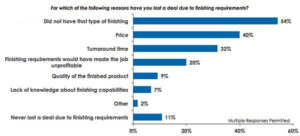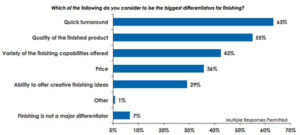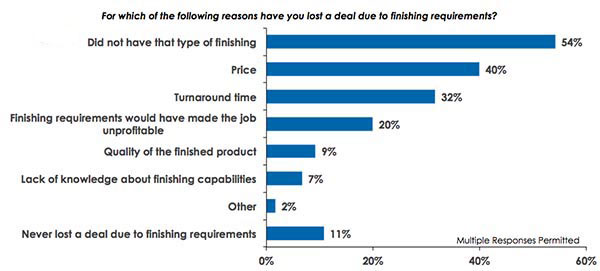By Mark DiMattei, manager, Keypoint Intelligence – InfoTrends
Virtually every printed document requires some type of finishing. Finishing documents with cutting, folding, binding and other methods is crucial to the production of any application. The expanding array of digital printing methods has changed the nature of finishing from large-scale devices focused on offset printing to automated methods that often occur alongside a production digital printer. To reach its true potential, the role of finishing must evolve as well. Recent research from Keypoint Intelligence – InfoTrends offers important insights on how print service providers (PSPs) can leverage finishing to win business and drive profitability, in the following ways:
- Finishing plays an important role in service differentiation and sales revenue.
- Quick turnaround is the most important differentiator associated with finishing, but offering options and the ability to be creative are great ways to stand out from the competition.
- Tracking the cost of finishing is vital for understanding its value.
- Respondents preferred to combine their offset presses and production digital print operations so they could use the same finishing equipment and, thereby, maximize their investments.
Finishing closes deals

Source: Market Trends in Print Finishing, Keypoint Intelligence – InfoTrends 2020
According to the Market Trends in Print Finishing study, many PSPs report that finishing has helped them to win deals. In fact, only 11% of respondents reported that they had ever lost a deal due to finishing requirements. Among those respondents who had lost deals because of finishing requirements, the most common reasons included not having the required finishing capabilities, followed by price and turnaround time. All three of these factors can feed upon one another. If shops don’t have the right capabilities, price and turnaround time can be impacted.
Finishing creates market differentiation
In addition to closing deals, finishing also can serve as a differentiator. Not surprisingly, respondents to the survey ranked quick turnaround and quality as the key differentiators of finishing. The ability to quickly complete a quality job grows in importance as run lengths decrease and customers demand ever-shorter delivery times. At the same time, however, it also is worth noting that a variety of finishing options and the ability to offer creative ideas also were important differentiators. Diverse, creative options enable PSPs to stand out from their competitors and grab the attention of consumers and clients.
Offset vs. digital

Offset and digital finishing options often are at odds. Longer offset runs tend to be better suited for finishing through dedicated manufacturing tools. Meanwhile, shorter runs and requirements for quick turnaround, naturally, do not lend themselves well to devices that take a long time to set up. Additionally, with the growing prevalence of high-speed inkjet digital printing systems, many PSPs find there is a requirement for higher volume and productive finishing tools that have new capabilities for finishing workflow and automation (offline or inline).
According to research, 80% of respondents that had digital print and offset press technologies generally preferred to use the same finishing equipment for both. Only 11% preferred to keep offset and digital production separate, while another 9% reported that combining digital and offset was not possible due to format and other requirements.
Regardless, there are benefits to co-locating digital print and offset printing capabilities.
Next steps
It is all well and good to consider the statistics of finishing options, but there are some actions PSPs can take to ensure that they’re getting the most out of finishing, including the following:
- Get a grip on current options. Evaluate how to leverage finishing in current offerings. Focus on the applications that require finishing (e.g., folded brochures, bound books or diecut promotional items).
- Keep an eye on costs. The only way to truly determine how valuable finishing can be is to keep track of all the related costs. Are budgeted hourly rates being used? Is finishing being charged separately? Once there is a thorough understanding of how finishing is accounted for, a better go-forward strategy can be developed.
- Budget for future purchases. Having a plan for additional equipment purchases ensures tracking of the investments required to sustain, build and grow the business. Even if finishing purchases only show up occasionally on a multi-year purchasing cycle, it always is a good idea to have a plan.
- Don’t forget to account for finishing when making digital print purchases. Printing solutions typically involve a substantial investment, but hidden costs sometimes are overlooked. It is important to consider the role that finishing will play when a new production digital print system is purchased.
The bottom line
Finishing may be one of the final steps for many print applications, but it should not be ignored until the end of the process. Although respondents to Keypoint Intelligence’s survey clearly believe that finishing capabilities can differentiate their businesses and contribute significantly to sales revenues, this does not necessarily mean that all PSPs are paying enough attention to finishing.
There still is work to be done, but most PSPs understand the value and benefits that finishing can deliver. Now is the time to think about how finishing can be applied to other business decisions – especially when making new investments in equipment.
Mark DiMattei is the manager of Keypoint Intelligence – InfoTrends’ publishing, editing and news department. This article originally appeared on WhatTheyThink.com. WhatTheyThink is the global printing industry’s leading market intelligence resource. Copyright ©2020 WhatTheyThink. All rights reserved. Reprinted with permission.





